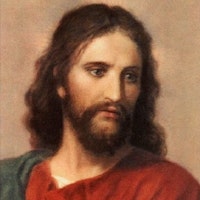You shall love the Lord your God with all your heart, and with all your soul, and with all your mind.
Jesus of Nazareth

The Great Commandment
Topic: Immanence & Transcendence
Teacher, which is the great commandment in the law?” Jesus said to him, “You shall love the Lord your God with all your heart, and with all your soul, and with all your mind. This is the great and first commandment. And a second is like it, You shall love your neighbor as yourself. On these two commandments depend all the law and the prophets.
Jesus of Nazareth is a cornerstone of spiritual thought, a figure whose influence transcends the boundaries of religious affiliation. Born around 4 BCE in Bethlehem, he is primarily known as the foundational figure of Christianity but also holds a significant role in Islam as a prophet. His life journey, from his humble birth to his baptism by John the Baptist, was marked by a public ministry that centered around themes of love, compassion, forgiveness, and justice. These teachings were accompanied by miraculous events, garnering a community of followers and disciples. His message aimed to shake the foundations of existing religious practices that were rigid and exclusive, offering instead a path rooted in compassion and inclusivity.
The Universal Christ concept enriches our understanding of who Jesus was and is. Especially emphasized in Franciscan traditions and mystical Christianity, this idea posits Jesus as a unique but not isolated manifestation of God's ongoing presence and action in the world. Through this lens, Jesus isn't just a figure confined to a particular time and space; he becomes an enduring representation of divine love and compassion. He serves as a window through which we can understand how God interacts with the world, offering a model for a potential divine-human union that respects the dignity and sacredness of all life forms.
In harmonizing these perspectives, we recognize Jesus both as a historical figure and as a transcendent representation of divine compassion. Whether viewed through the lens of traditional faith narratives or the broader scope of the Universal Christ, Jesus emerges as a teacher who calls us to enact love and compassion in our lives. His teachings, whether seen as divine or profoundly humane, offer a framework for community and interconnectedness that continues to be relevant across different cultures and religious beliefs. In a world often fractured by division and lack of understanding, the multi-faceted legacy of Jesus offers a timeless lesson in the transformative power of compassion.
The Gospel of Matthew
Wilson, Andrew, editor. World Scripture II. Universal Peace Federation, 2011, p. 702 [Matthew 22.36-40].

Jesus of Nazareth
Theme: Intimate Divinity

About This Quotation By Jesus [Commentary]
“Teacher, which is the great commandment in the law?” Jesus Christ is asked, and Jesus answers in a single, clarifying line: “You shall love the Lord your God with all your heart, and with all your soul, and with all your mind. This is the great and first commandment.” The word “all” matters here. Jesus gathers the whole person—heart, soul, and mind—into one undivided love of God, not a partial or occasional devotion.
Jesus Christ then adds, “And a second is like it, You shall love your neighbor as yourself.” The “second” is “like it,” not separate from it. Loving God “with all your heart, and with all your soul, and with all your mind” is joined to loving “your neighbor as yourself,” in the ordinary duties and encounters of the day. It calls for the same care you would want for your own life, without self-neglect and without self-importance.
Jesus Christ concludes, “On these two commandments depend all the law and the prophets.” Love of God and love of neighbor are not side teachings; they hold everything else. Everyday Divinity is practiced on this ground—wholehearted love for God, and concrete love for “your neighbor as yourself”—so that what is sacred is not kept at a distance but carried into daily life.
Matthew 22.36-40
Related Quotes
Copyright © 2017 – 2026 LuminaryQuotes.com About Us